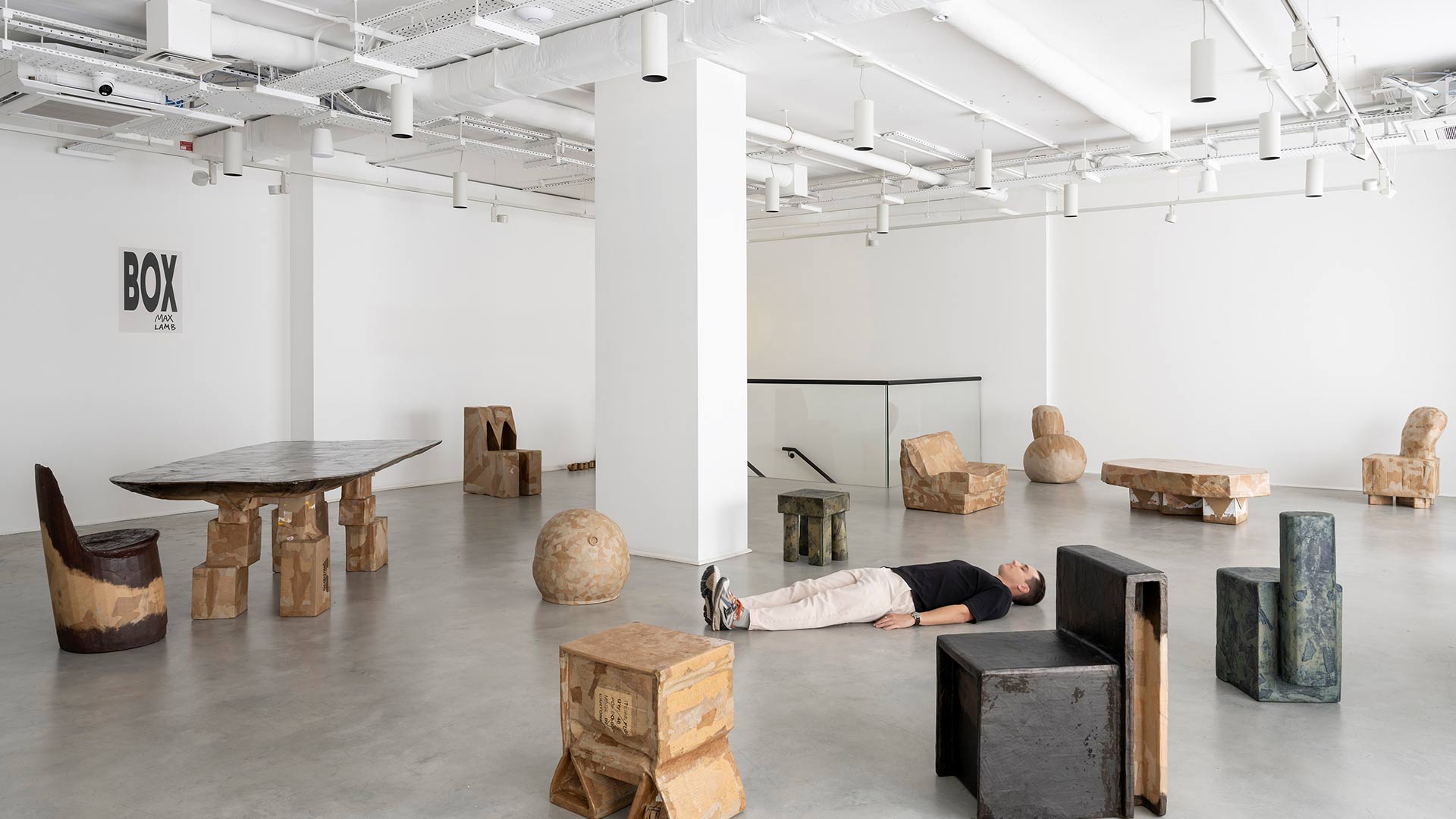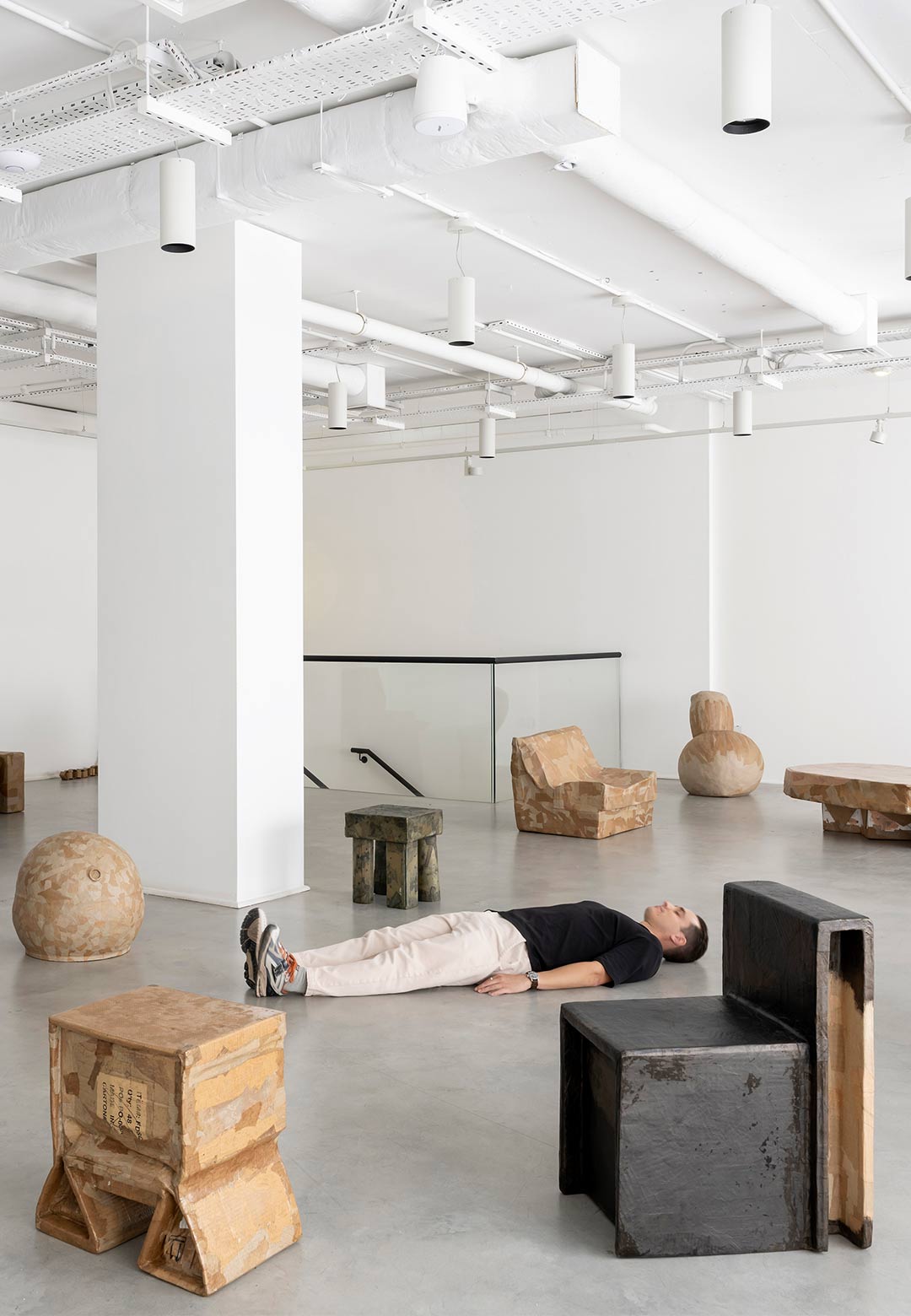Gallery FUMI in London unveiled a major exhibition of new works by British designer Max Lamb titled BOX, comprising an array of 30 objects made entirely of cardboard. By connecting art and anthropology to materiality and improvisation, Lamb creates pieces that embody new histories of craft while giving value to a material often seen as secondary. BOX by Max Lamb is on display from October 5 - November 18, 2023.
“Most corrugated cardboard boxes are constructed from three or five layers of unbleached, pulped recycled paperboard, with every other layer being fluted (corrugated) to give thickness, lightness, structure and impact resistance. They are wholly derived from plants—wood fibres for the layers of brown paper which are glued together using starch from tubers, seeds and roots such as potatoes, wheat, rice and tapioca,” shares Lamb, who is also an interior designer.
In his practice, the London-based furniture designer works at the crossroads of contemplative discovery and sustainable design, firmly breaking away from traditional processes by developing his singular typologies that blend art, design and functionality. A childhood spent outdoors adventuring in Cornwall and working on his grandfather’s Yorkshire farm nurtured his curiosity and creative spirit, as well as his ability to handle raw and industrial materials to problem-solve. His proclivity for experimentation and deftness with tools and materials have galvanised his use of unconventional techniques, resulting in an array of distinct pieces that value the human touch and the individual maker.
“Cardboard boxes are usually secondary in importance to their contents, yet beautiful in material and design. My work using cardboard boxes is as much about the raw constituents as the forms and volumes of the boxes themselves, and an exercise in both construction and deconstruction intended to give primary function and value to the material. Some of the cardboard boxes I’ve accumulated over the last few years lent themselves to being reinterpreted as furniture designs by simply stacking or joining two or more boxes together, even if only for a component like a backrest, seat or leg. Other boxes required greater manipulation to enhance their structure or to alter their proportions or shape, by cutting, scoring, folding, rolling or cross-laminating, before glueing them back together again, always conscious not to generate further offcuts or waste,” explains Lamb.
Catalysed by his interest in sustainability and intrigued by the challenge of giving scrap material primary value, the product designer sought to make use of the ever-increasing piles of cardboard accumulating in his studio. Surplus materials included unbleached cardboard tubes used to store and transport his 'space-dyed' tufted rugs, surplus quality corrugated cardboard gathered over time from museum loans and various workshop projects, as well as everyday delivery boxes with varying shapes, colours, and textures.
"Unavoidable scraps went into a bucket of water along with cardboard salvaged from less usable boxes to make the strips of soggy brown paper I used for one of the final processes—paper mache. The porosity of the paper and solubility of the adhesive used in box manufacture meant the cardboard delaminated very quickly when briefly soaked in water, which made the paper pliable enough to form complex shapes. I built layer upon layer of torn strips laced with wheat paste, which when dry created a structural exoskeleton over the assemblies of boxes and cardboard constructions," Lamb relays.
Working with or against pre-cut shapes by cutting, scoring, folding, crushing and reassembling with bolts, screws, paper gum tape and a home-made wheat-based glue (flour and water), Lamb assembles volumes of cardboard into forms, building up layers of the ubiquitous brown paper to create structural integrity like that of rock or wood, while retaining evidence of the making. Although achieving durability while preserving the personality of the material proved a challenge, Lamb has successfully elevated the product designs from an exercise in form building to exquisite, intriguing pieces.
Elaborating on the creative process of putting together the furniture pieces for BOX, Max relays, "The glue is simply plain flour and water heated for a few minutes until dissolved to create a gelatinous paste offering superb compatibility with the porous paper. I chose to use wheat paste as the crop is native to the UK and flour is both readily available and very quick to make into glue. I also romanticised I might be using flour milled from wheat grown by my Grandfather on his Yorkshire farm. On surfaces where it was needed, I coated some of my cardboard furniture using linseed oil paints, or tempera paint made from wheat paste mixed with earth oxides such as tin and iron. But the protagonist is the box; box as raw material, as paper, then back to box, albeit now ‘Box Stool,’ ‘Box Table’ or ‘Box Chair'."
Transforming this ephemeral, and often single-use and undervalued material into functional, beautiful and sustainable furniture, Lamb has been a collaborator and friend of Gallery FUMI for over 15 years and has been firmly rooted in its nucleus since its inception. “From the early days when we showed (Lamb’s) first works at our original gallery in Shoreditch, we've watched him grow alongside us. His latest project is a true testament to his talent and creativity and we feel fortunate to be a part of his artistic journey,” shares Gallery FUMI's co-founder, Valerio Capo.
'Box' by Max Lamb is on display from October 5 - November 18, 2023, at Gallery FUMI, London, UK.






 Sign in with email
Sign in with email










What do you think?